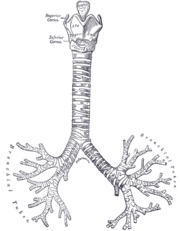
Respiratory tree
Encyclopedia

Vertebrate
Vertebrates are animals that are members of the subphylum Vertebrata . Vertebrates are the largest group of chordates, with currently about 58,000 species described. Vertebrates include the jawless fishes, bony fishes, sharks and rays, amphibians, reptiles, mammals, and birds...
lung
Lung
The lung is the essential respiration organ in many air-breathing animals, including most tetrapods, a few fish and a few snails. In mammals and the more complex life forms, the two lungs are located near the backbone on either side of the heart...
. Beginning with the top of the respiratory system, the trachea
Vertebrate trachea
In tetrapod anatomy the trachea, or windpipe, is a tube that connects the pharynx or larynx to the lungs, allowing the passage of air. It is lined with pseudostratified ciliated columnar epithelium cells with goblet cells that produce mucus...
, the order of branchings is as follows:
- trachea
- main bronchusBronchusA bronchus is a passage of airway in the respiratory tract that conducts air into the lungs. The bronchus branches into smaller tubes, which in turn become bronchioles....
:------ lobar bronchus
- segmental bronchus
- conducting bronchioleBronchioleThe bronchioles or bronchioli are the first airway branches that no longer contain cartilage or glands in their submucosa. They are branches of the bronchi.The bronchioles terminate by entering the circular sacs called alveoli.- Structure :...
- terminal bronchioleTerminal bronchioleA terminal bronchiole is a bronchiole at the end of the conducting zone. At the transition into the respiratory zone, alveoli become present.The terminal bronchiole is the most distal segment of the conducting zone. Each of the terminal bronchioles divides to form respiratory bronchioles which...
- respiratory bronchioleRespiratory bronchioleThe respiratory bronchioles are interrupted by alveoli which are thin walled evaginations. Alveolar ducts are distal continuations of the respiratory bronchioles.-External links:*...
- alveolar ductAlveolar ductAlveolar ducts are the tiny end ducts of the branching airways that fill the lungs. Each lung holds approximately 1.5 to 2 million of them. The tubules divide into two or three alveolar sacs at the distal end. They are formed from the confluence openings of several alveoli...
- alveolar sac
- alveolus
- alveolar sac
- alveolar duct
- respiratory bronchiole
- terminal bronchiole
- conducting bronchiole
- segmental bronchus
- lobar bronchus
- main bronchus
At each division point or generation, one airway branches into two or more smaller airways. The human respiratory tree may consist of up to 28 generations, while the respiratory tree of the mouse
Mouse
A mouse is a small mammal belonging to the order of rodents. The best known mouse species is the common house mouse . It is also a popular pet. In some places, certain kinds of field mice are also common. This rodent is eaten by large birds such as hawks and eagles...
has up to 13 generations. Proximal divisions (those closest to the top of the tree, such as the bronchi) mainly function to transmit air to the lower airways. Latter divisions including the respiratory bronchiole, alveolar ducts and alveoli, are specialized for gas exchange
Gas exchange
Gas exchange is a process in biology where gases contained in an organism and atmosphere transfer or exchange. In human gas-exchange, gases contained in the blood of human bodies exchange with gases contained in the atmosphere. Human gas-exchange occurs in the lungs...
.

